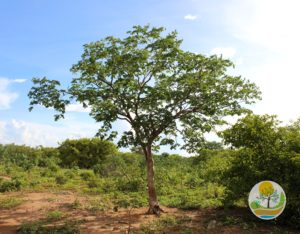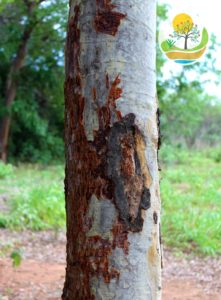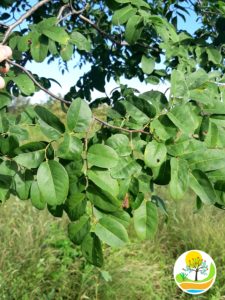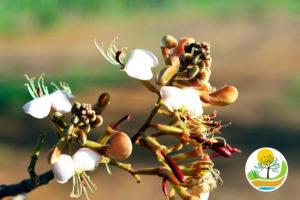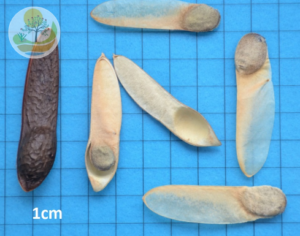General information
Scientific nomenclature
Amburana cearensis is currently found within the Class Equisetopsida C. Agardh , Subclass Magnoliidae Novak ex Takht., Superorder Rosanae Takht., Order Fabales Bromhead, Family Fabaceae Lindl., Genus Amburana Schwacke & Taub. (TROPICOS.ORG).
- Nomenclature error
In the Amazon region, especially in the states of Acre and Rondônia, there is another Amburana species (Amburana acreana (Ducke) A.C.Sm.), which has the same properties as A. cearensis. However, it grows way taller, and still some authors considere as being from the same species (LORENZI, 2008).
Rizinni (1978) says that, even though both species are very similar, the A. cearensis has 7 to 11 round leaflets per leaf, and smaller and more compact inflorescence, while the A. acreana has 17 to 25 sharp leaflets, and a larger and looser inflorescence.
Local names
Cumaru, Cerejeira, Cerejeira-rajada, Cumaru-das-caatingas, Imburana-de-cheiro, Amburana, Cumbaru, and Umburana-macho (LORENZI, 2008; RIZZINI, 1978; MAIA, 2012).
According to Maia (2012), in Argentina this species is known as Roble criollo, in Bolivia as Tumi, in Paraguay as Palo rébol, and in Peru as Ishpingo.
Ecological importance
The A. cearensis is a deciduous pioneer, heliophyte, selective xerophyte species, found in limestone outcrop areas, and deciduous forest in dry areas (LORENZI, 2008). It requires shadow in its initial growth phase, commonly seen in secondary vegetation. In the state of Ceará, Cumaru is an important tree, showing adaptation to all kinds of soil, but with preference to deep sandy soils. Easily found in abundance in the dry slopes of Caatinga, and in the deep soils of tablelands.
Fenology
Soon…
Geographic distribution
Arid regions of Brazil, especially in the northern’s Caatinga (states of Ceará, Rio Grande do Norte, Paraíba, and Pernambuco) (MAIA, 2012; RIZINI, 1978). Also found in between the states of Minas Gerais and north of Argentina, northeast of Paraguay, south of Bolivia, and northeast of Peru. In Brazil, its ecological range goes from the Caatinga to the rainforest of Vale do Rio Doce, in the states of Espirito Santos and Minas Gerais, reaching the limestone outcrops and deciduous forests of Middle-West and Southeast regions of Brazil (MAIA, 2012).
Botanic description
Size, crown shape, color, growth habit
In the Caatinga, it grows as high as 6-8 m (about 20 to 26ft), but in favorable conditions it may reach 10-12 m (33.9 to 39ft) (MAIA, 2012), and 10-20m in deciduous rainforest (LORENZI, 2008).
This species can be easily recognized for its characteristic bark, with no thorns and apparent smell of coumarin, and for its fruit (MAIA 2012).
Vegetative characteristics
- Stem, bark, and wood
Lima (2012) describes the tree: trunk with an average diameter of 20-30 cm (about 7.8 to 11.8in), smooth bark (color varying from brownish to reddish-brown) detaching in fine and large sheets; light-brown branches, glabrous or with short dark-brown hairs, and white lenticels.
The soft wood has a density of 0.6 g/cm³ (moderately heavy), from beige to light-brown color, and smell of coumarin, which partially preserves itself when expose do inclement weather (LORENZI, 2008; MAIA, 2012).
- Leaves
Compound leaves, with an opposite arrangement (LIMA, 2012); 7 to 11 leaflets of 2.5-5 cm x 1-2.5 cm in length (MAIA, 2012), papyraceous, elliptical to oval, with base rounded or truncated, obtuse to slightly acute tip, and glabrous upper face and sparse hair in the down side.
- Flower/inflorescence
Soon…
- Fruit and seeds
According to Rizzini (1978), its fruit is a legume-type (reminding a open duck peak), striped in black in the outside, smooth and yellow on the inside, slender, hard, and averaging 7-9 x 2 cm. Its valves bend backwards when fruit is opening.
Yellowish seeds are flattened (1-2 cm), rich in coumarin, and nice smell of vanilla, located in the upper third of the fruit, presenting a basal wing of 5 cm in length, which makes possible its dispersion by wind (LIMA, 2012; MAIA, 2012). Woody-texture tegument and marble coloration, rough and opaque (CUNHA & FERREIRA, 2003). They are not attacked by- insects (MAIA, 2012).
< Go back to main page >
REFERENCES
-
CUNHA, M. C. L.; FERREIRA, R. A. Aspectos Morfológicos da Semente e do Desenvolvimento da Planta Jovem de Amburana cearensis (Arr. Cam.) A. C. Smith – Cumaru – Leguminosae Papilionoideae. Revista Brasileira de Sementes, vol. 25, n. 2, p.89-96, 2003.
-
LIMA, B. G. Caatinga: espécies lenhosas e herbáceas. 1. ed. Mossoró, RN: EdUfersa, 2011. 316 p.
- LORENZI, H. Árvores Brasileiras: Manual de Identificação e Cultivo de Plantas Arbóreas Nativas do Brasil. 5. ed. Nova Odessa, SP: Instituto Plantarum, 2008. Vol. 1. 384 p.
- LORENZI, H.; MATOS, F. J. A. Plantas Medicinais no Brasil: Nativas e Exóticas. 2. ed. Nova Odessa, SP: Instituto Plantarum, 2008. Vol. 2. 576 p.
-
MAIA, G. N. Caatinga: árvores e arbustos e suas utilidades. 2. ed. Fortaleza, CE: Printcolor Gráfica e Editora, 2012. 413 p.
-
RIZZINI, C. T. Árvores e Madeiras Úteis do Brasil: Manual de Dendrologia Brasileira. 2. ed. São Paulo, SP: Blucher, 1978. 304 p.

